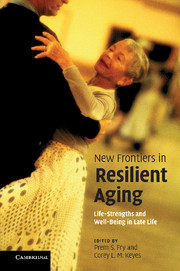Book contents
- Frontmatter
- Contents
- Figures
- Notes on contributors
- Foreword
- Acknowledgments
- Introduction
- 1 Sources of human life-strengths, resilience, and health
- 2 Growth is not just for the young: growth narratives, eudaimonic resilience, and the aging self
- 3 Physical resilience and aging:
- 4 You can teach an old dog new tricks:
- 5 Resilience in the face of cognitive aging:
- 6 Why do some people thrive while others succumb to disease and stagnation?
- 7 Psychosocial resources as predictors of resilience and healthy longevity of older widows
- 8 Resilience and longevity:
- 9 The socioemotional basis of resilience in later life
- 10 Emotional resilience and beyond:
- 11 Risk, resilience, and life-course fit:
- 12 Resilience in mobility in the context of chronic disease and aging:
- 13 Positive aging:
- Index
- References
12 - Resilience in mobility in the context of chronic disease and aging:
cross-sectional and prospective findings from the University of Alabama at Birmingham (UAB) Study of Aging
Published online by Cambridge University Press: 06 December 2010
- Frontmatter
- Contents
- Figures
- Notes on contributors
- Foreword
- Acknowledgments
- Introduction
- 1 Sources of human life-strengths, resilience, and health
- 2 Growth is not just for the young: growth narratives, eudaimonic resilience, and the aging self
- 3 Physical resilience and aging:
- 4 You can teach an old dog new tricks:
- 5 Resilience in the face of cognitive aging:
- 6 Why do some people thrive while others succumb to disease and stagnation?
- 7 Psychosocial resources as predictors of resilience and healthy longevity of older widows
- 8 Resilience and longevity:
- 9 The socioemotional basis of resilience in later life
- 10 Emotional resilience and beyond:
- 11 Risk, resilience, and life-course fit:
- 12 Resilience in mobility in the context of chronic disease and aging:
- 13 Positive aging:
- Index
- References
Summary
Abstract
The purpose of this chapter is to provide a conceptual basis for using life-space to assess mobility resilience and maintenance of social participation among community dwelling older adults. The Life-Space Assessment (LSA) measures mobility and the geographic scope of participation in society over one month. It reflects distance, frequency, and use of equipment or personal help while ambulating through the environment. An LSA score of 60 or higher defines an unrestricted life-space – a level of mobility and participation that operationalizes resilience among older adults. After reporting results of a qualitative study examining attitudes toward life-space mobility, we report cross-sectional and prospective data from an observational cohort study of community-dwelling older adults. Significant associations between life-space mobility with social participation, as well as specific correlates and predictors of life-space mobility resilience, are defined.
The importance of life-space resilience as a reflection of mobility and social participation among community-dwelling older adults
An important aspect of resilience is the ability to maintain function in the context of chronic disease and age-associated physiological changes. Available data suggest that 80 percent of persons over the age of 65 years have at least one chronic condition and 20 percent have four or more such conditions (Chodosh et al., 2005). Age-associated physiological changes have been well documented in all organ systems (Hazzard et al., 2003).
Information
- Type
- Chapter
- Information
- New Frontiers in Resilient AgingLife-Strengths and Well-Being in Late Life, pp. 310 - 339Publisher: Cambridge University PressPrint publication year: 2010
References
Accessibility standard: Unknown
Why this information is here
This section outlines the accessibility features of this content - including support for screen readers, full keyboard navigation and high-contrast display options. This may not be relevant for you.Accessibility Information
- 23
- Cited by
